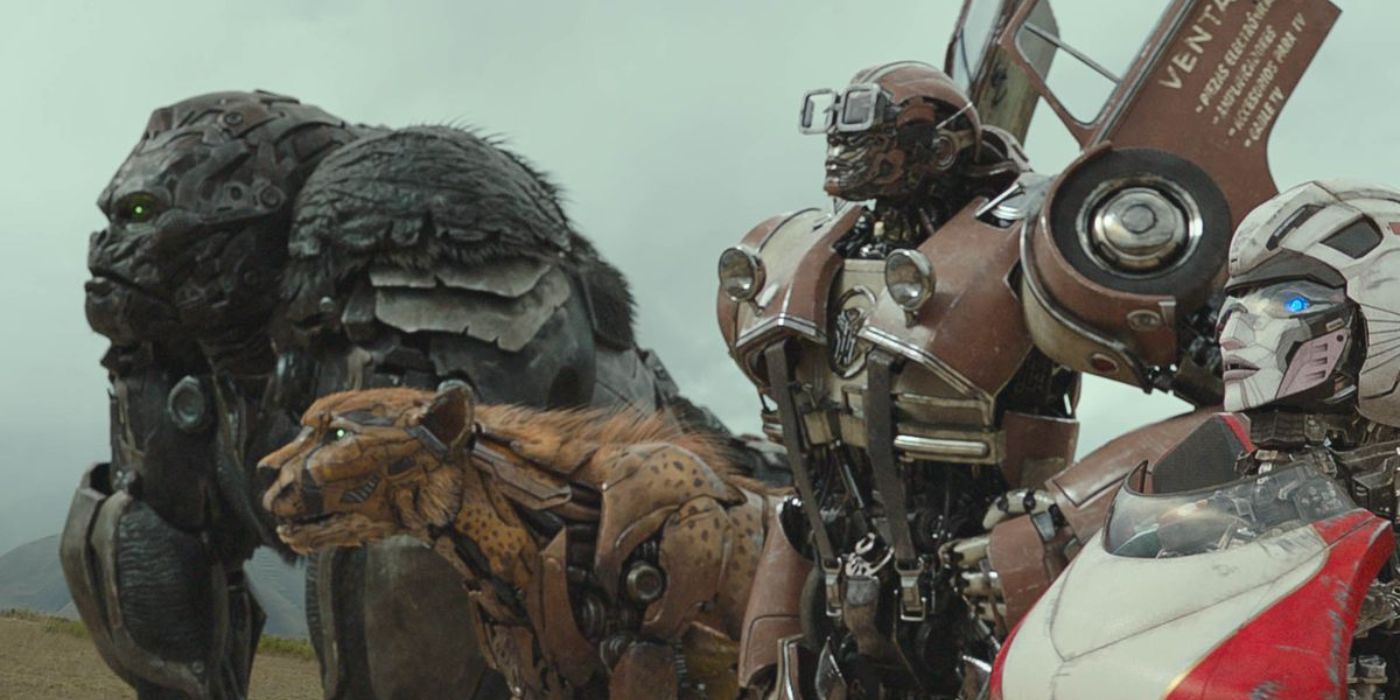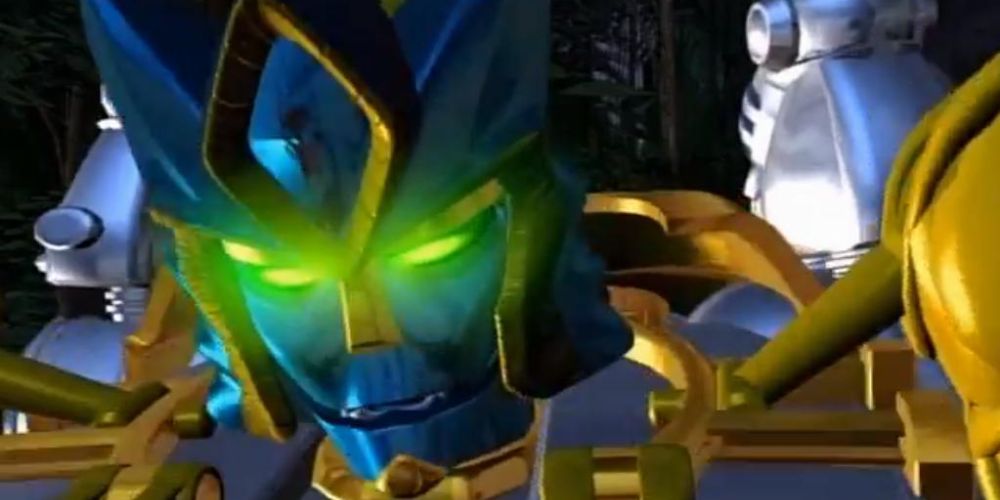The Big Picture
- Transformers: Rise of the Beasts fails to fully realize the complex characters from Beast Wars, disappointing fans of the series.
- The film only brings four Maximal characters to the big screen, neglecting the majority of the Beast Wars cast.
- The Maximals that do appear in the film, Cheetor and Rhinox, are relegated to the background and lack the depth and personality of their televisual counterparts.
While fans of the live-action Transformers series have been waiting five years for Transformers: Rise of the Beasts — the previous entry, Bumblebee, was met with unexpectedly positive reviews in 2018 — fans of Beast Wars: Transformers having been waiting for a big screen adaptation of the series since the first Transformers movie debuted back in 2007. Rise of the Beasts promised to bring the Maximals, the heroic faction of the Beast Wars series into the live-action fold. While fans of the film franchise may be satisfied by the Rise of the Beasts’ merging of Michael Bay-style action with the heart of Bumblebee, fans of Beast Wars are sure to be disappointed by the film’s failure to fully realize the complex characters it adapts from the show.
Transformers: Rise of the Beasts
During the ’90s, a new faction of Transformers – the Maximals – join the Autobots as allies in the battle for Earth.
- Release Date
- June 9, 2023
- Director
- Steven Caple Jr.
- Cast
- Anthony Ramos, Dominique Fishback, Domenic Di Rosa
- Rating
- PG-13
- Runtime
- 127 minutes
- Genres
- Sci-Fi, Action, Adventure
What Is ‘Beast Wars: Transformers’?
Rise of the Beasts’ newest Transformer characters come from Beast Wars: Transformers, which aired for three seasons from 1996 to 1999. The show represented a rapid departure from previous Transformers media. Though a sequel to the franchise’s first generation, the show takes place hundreds of years after the events of Generation 1, with almost entirely new characters. Narratively, the series focuses on the battle between the Maximals and the Predacons, the descendants of the Autobots and the Decepticons, respectively. While the first generation’s characters famously transform into automobiles, the Maximals and Predacons transform into a diverse array of animals, from Optimus Primal’s (Garry Chalk) gorilla to Megatron’s (David Kaye) tyrannosaurus. Additionally, the series also changes the traditional animation style previously used to bring the Transformers to life as one of the first fully computer-animated programs.
Despite these stark changes, Beast Wars managed to appease initially skeptical fans over the course of its three-season run by delivering cutting edge animation, consistently engaging storytelling, and exploring a bevy of mature themes. What makes all of these winning elements shine, though, are the compelling, well-written characters that populate the world of Beast Wars on both sides of the battle. From the honor-bound Dinobot (Scott McNeil) to the allegiance-shifting Blackarachnia (Venus Terzo), Beast Wars featured an ensemble of multi-dimensional heroes and villains across its run.
How Does ‘Transformers: Rise of the Beasts’ Adapt ‘Beast Wars’?
Rise of the Beasts is not an adaptation of any storyline from Beast Wars. Rather, the film adapts a select number of characters from the television series and incorporates them into the extant world of the Transformers live-action films. Out of the large catalog of Maximals and Predacons to choose from, Rise of the Beasts only brings four characters to the big screen, Optimus Primal (Ron Perlman), Airazor (Michelle Yeoh), Cheetor (Tongayi Chirisa), and Rhinox (David Sobolov), all of whom are Maximals. Each of these characters’ beast modes are given a new design, all of which feature a blending of their robotic and animalistic attributes, rather than being exclusively animal like in Beast Wars. When it comes to their characterization is where Rise of the Beasts fails to do justice to Beast Wars.
How Does ‘Transformers: Rise of the Beasts’ Fail Its ‘Beast Wars’ Characters?
One could immediately argue that Rise of the Beasts doesn’t do justice to its source material simply because of the sheer lack of Beast Wars characters brought to the big screen. The film doesn’t bring a single Predacon into the live-action universe, meaning audiences have to miss out on characters like the mad scientist Tarantulas (Alec Willows) and the campy rage-monster Inferno (Jim Byrnes). However, Rise of the Beasts is, obviously, just one entry in a continuing franchise, so it is reasonable to assume the Predacons are being saved for a sequel. After all, if this film really is the “rise” of the beasts — surely there are more in store.
While it is reasonable for the Predacons to be absent from Rise of the Beasts, what is unforgivable is how lost the Maximals who do make it on the screen are in translation. Unsurprisingly, the film does its best with Primal. The live-action franchise has routinely centered Optimus Prime (Peter Cullen) in each of the films, so it makes sense that the Beast Wars character given the most to do would be the Maximals’ leader. Not only is Primal the most significant Maximal plot-wise, but Primal is also given the most dialogue and is framed best by the camera. Primal gets to be the one to deliver the iconic, “Maximals, maximize!” line in the climactic fight scene, tying him to the film’s most memorable nostalgic Beast Wars moment.
But the “maximize!” moment really only showcases Primal. The sweeping camera fails to settle on either Cheetor or Rhinox long enough to showcase their transformed designs, failing to make this transformation have much meaning for any of the characters other than Primal. And, as discussed below, Airazor does not even make it to this point in the film. Though this may seem like a nitpicky complaint, rewatching any of the Transformers films demonstrates that this franchise communicates which characters are significant based on how much cinematographic attention is given to their transformations. The film, therefore, deems Cheetor and Rhinox to be of lesser significance than almost any of the other robot characters.
The film’s failure to bring Cheetor or Rhinox to life is apparent far before the film even gets to its nostalgic Beast Wars moment, though. The film treats both characters as set dressing, failing to give much of any personality to either character. Cheetor has, at most, a handful of lines, and if Rhinox has any lines at all, they are in chorus with other characters. Throughout the film, then, when the Maximals do actually appear — they are off-screen for a surprising amount of time for a film with “beasts” in the title — Cheetor and Rhinox are relegated to the background. This is especially shameful because of how rich both characters are in their televisual forms.
Who Were Cheetor, Rhinox, and Airazor in ‘Beast Wars: Transformers’?
In the first season of Beast Wars, Cheetor (Ian James Corlett) is introduced as the overly eager youngster of the Maximals. He reveres Optimus Primal as a leader, but desperately wants to prove himself as a hero in his own right. He learns much about being a warrior from his fellow Maximals, and after he mutates into his transmetal form in Season 2, Cheetor becomes a successful, self-sufficient fighter. After surviving a feral transformation in the show’s third season, Cheetor takes to teaching two prehistoric children how to use tools, demonstrating his evolution over the course of the series from student to teacher.
Rhinox (Richard Newman), meanwhile, spends all three seasons as the group’s most thematically resonant character. Though he packs the brute force of his rhinoceros form, and packs a wallop with his rotating chainguns, Rhinox is, at his core, a gentle giant. He is both the Maximals’ tech expert, as well as being spiritually connected to nature. As Beast Wars (as well as its sequel series Beast Machines: Transformers) are thematically interested in how to find the balance between the natural and technological, Rhinox’s characterization captures the essence of the show.
While it would be unreasonable to expect Rise of the Beasts could capture the full spirit of either Cheetor or Rhinox, or faithfully adapt their individual arcs from a three-season show into a single feature-length film, the seventh Transformers film doesn’t even try to bring their cinematic counterparts to life. None of Cheetor’s few lines suggest he’s a young Transformer learning to be a hero. There is no shot of Rhinox basking in the beauty of nature or using his iconic chainguns in battle. By giving no reverence to either Maximal’s character, Rise of the Beasts fails to even adapt the characters as one-note echoes of their former selves.
Unlike Cheetor and Rhinox, Airazor actually does get a bit of screen time in Transformers: Rise of the Beasts. But, as suggested by the description of the “maximize!” moment, she doesn’t even survive long enough to be depicted transforming. In Rise of the Beasts’ second act, Airazor is killed by Primal after she’s infected with an underexplained evil by the film’s villain, Scourge (Peter Dinklage). Before she’s infected, though, she is the first Maximal the film’s protagonists meet, and she does help guide them on their journey.
Despite her slightly larger amount of screentime, though, Rise of the Beasts fails to translate the character from her televisual origins. Throughout most of Beast Wars, Airazor’s (Pauline Newstone) arc runs parallel to that of Tigatron (Blu Mankuma). The two routinely go on missions together, and Tigatron’s respect for Airazor’s loyalty, dedication to the Maximals, and heroism convince Tigatron to fully dedicate himself to the Maximals’ objectives. The two Transformers develop a romantic bond and profess their love for one another when they are tragically killed in the show’s second season. The two are even reincarnated together as the ultra-powerful Tigerhawk (Mankuma) in the third season. The core of Airazor’s characterization is thus tied directly to her team and to another character. Even without including Tigatron, Rise of the Beasts could have translated her character by focusing on Airazor’s relationship with the other Maximals. However, because Cheetor’s and Rhinox’s characters are non-existent, and because Airazor spends so much of her time isolated from the rest of the Maximals — she enters the film alone while the other Maximals have been hiding out together when the protagonists meet them — the only sustained interaction between Airazor and her team comes when Primal kills her. And, by killing her in Rise of the Beasts, there is no potential for her character (one of the few female Beast Wars characters, mind you) to be explored further in future films.
In many ways, Rise of the Beasts is an improvement over many of the Transformers sequels. Credit where it’s due, too, the film does a much better job than most of its relatives in developing worthwhile human characters. Yet, the focus on developing the human characters seems to have come at the cost of giving the Maximals the screen treatment they deserve.
Transformers: Rise of the Beasts is available to stream on Paramount+ in the U.S.
Watch on Paramount+
Source link


